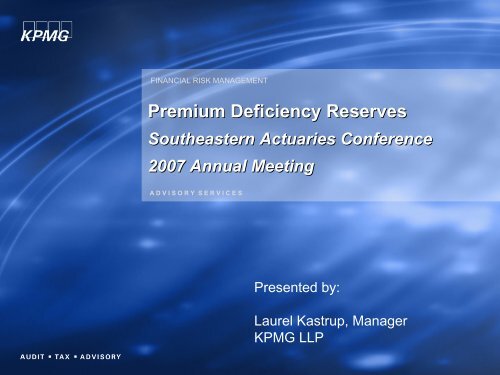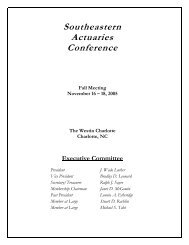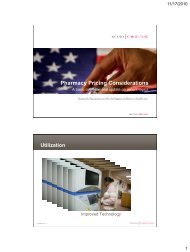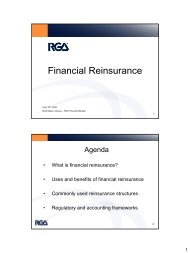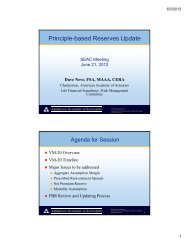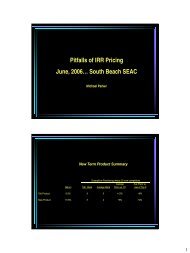Premium Deficiency Reserves - Southeastern Actuaries Conference
Premium Deficiency Reserves - Southeastern Actuaries Conference
Premium Deficiency Reserves - Southeastern Actuaries Conference
You also want an ePaper? Increase the reach of your titles
YUMPU automatically turns print PDFs into web optimized ePapers that Google loves.
FINANCIAL RISK MANAGEMENT<strong>Premium</strong> <strong>Deficiency</strong> <strong>Reserves</strong><strong>Southeastern</strong> <strong>Actuaries</strong> <strong>Conference</strong>2007 Annual MeetingA D V I S O R Y S E R V I C E SPresented by:Laurel Kastrup, ManagerKPMG LLP©2007 KPMG LLP, the U.S. member firm of KPMG International, a Swiss cooperative. All rights reserved. FOR INTERNAL USE ONLY.1
AgendaAnother PDRThe PDR ProblemAccounting PerspectiveFinancial Reporting PerspectiveCompany PerspectiveQ&A©2007 KPMG LLP, the U.S. member firm of KPMG International, a Swiss cooperative. All rights reserved. FOR INTERNAL USE ONLY.2
Another PDR Paper?!NAIC Discussions & Industry Inconsistencies led to thewhite paper to provide insight into:Testing for the need for PDRsManner in which a PDR might be determinedDetails around financial reporting of PDRs<strong>Actuaries</strong> are not in any way bound to comply withpractices described or conform their work topractices©2007 KPMG LLP, the U.S. member firm of KPMG International, a Swiss cooperative. All rights reserved. FOR INTERNAL USE ONLY.3
What’s New In the PaperExamplesFinancial ReportingAppendix III—addresses various issuesFrequently Asked QuestionsThroughout the paper©2007 KPMG LLP, the U.S. member firm of KPMG International, a Swiss cooperative. All rights reserved. FOR INTERNAL USE ONLY.4
The Problem<strong>Actuaries</strong> often lack a thorough understanding of theaccounting implicationsLack of communication and/or understanding betweenactuaries and accountantsInconsistent guidance and practicesThe white paper gives examples to provideinsight into PDR process and implications©2007 KPMG LLP, the U.S. member firm of KPMG International, a Swiss cooperative. All rights reserved. FOR INTERNAL USE ONLY.5
Statutory Accounting PerspectiveFocus on SolvencyPDR is a toolEstablishes a reserve that reduces the reporting entity’sstatutory capital and surplusIdentifies situations that could result in possibleimpairment©2007 KPMG LLP, the U.S. member firm of KPMG International, a Swiss cooperative. All rights reserved. FOR INTERNAL USE ONLY.6
GAAP Accounting PerspectiveFocus on Reporting of Income Properly Allocated tothe Reporting Period“Purpose for PDR is the recognition and appropriatedisclosure of a contingent obligation that may affectan interested person’s s judgment of the financial valueand ongoing financial vitality of a businessenterprise.”©2007 KPMG LLP, the U.S. member firm of KPMG International, a Swiss cooperative. All rights reserved. FOR INTERNAL USE ONLY.7
Financial Reporting PerspectiveBalance SheetWithholds an amount to fund the future benefits andexpenses from an entity’s s net worthEnsures that guarantees will be adequately fundedIncome StatementMoves losses from one reporting period to an earlierperiodIn later years, as the PDR is reduced, it will offset the loss it iwas established to cover©2007 KPMG LLP, the U.S. member firm of KPMG International, a Swiss cooperative. All rights reserved. FOR INTERNAL USE ONLY.8
Authority over PDRThe PDR is an actuarial reserve and is to be containedin any actuarial opinion of the reserves of a healthentity. Thus, both actuarial standards and accountingstandards may have to be consulted.©2007 KPMG LLP, the U.S. member firm of KPMG International, a Swiss cooperative. All rights reserved. FOR INTERNAL USE ONLY.9
Authority over PDRASOPsSSAP 54NAIC Health <strong>Reserves</strong> Guidance ManualFAS 60AICPA’s Audit and Accounting Guides©2007 KPMG LLP, the U.S. member firm of KPMG International, a Swiss cooperative. All rights reserved. FOR INTERNAL USE ONLY.10
General PrinciplesWhen judging Methods and Assumptions, keep inmind…Situations that should result in PDRBlock will experience losses over the near termBlock will be profitable in near term, but unprofitable overprojection period due to long-term guaranteesMinimize “false positives”Minimize “false negatives”©2007 KPMG LLP, the U.S. member firm of KPMG International, a Swiss cooperative. All rights reserved. FOR INTERNAL USE ONLY.11
Company PerspectiveWhen is a PDR Necessary?•Short Term <strong>Deficiency</strong>?•Focus on Year End Valuation Date?•Product Specific?•Case Size?•Case by Case?•Statvs GAAP?©2007 KPMG LLP, the U.S. member firm of KPMG International, a Swiss cooperative. All rights reserved. FOR INTERNAL USE ONLY.12
Company PerspectiveHow?•Time Horizon?•Impact and Timing of Corrective Action?•Expenses?•Claim <strong>Reserves</strong>?•Time Value of Money?©2007 KPMG LLP, the U.S. member firm of KPMG International, a Swiss cooperative. All rights reserved. FOR INTERNAL USE ONLY.13
Main Challenges with PDRsAssumptions/MethodsBusiness to be includedContract GroupingProjection PeriodsExpenses©2007 KPMG LLP, the U.S. member firm of KPMG International, a Swiss cooperative. All rights reserved. FOR INTERNAL USE ONLY.14
Business to Be IncludedNew Business?Known premium-deficient contracts©2007 KPMG LLP, the U.S. member firm of KPMG International, a Swiss cooperative. All rights reserved. FOR INTERNAL USE ONLY.15
Contract GroupingMuch debateConsistencyMarketed, Serviced and MeasuredHow granular should the analysis be?©2007 KPMG LLP, the U.S. member firm of KPMG International, a Swiss cooperative. All rights reserved. FOR INTERNAL USE ONLY.16
Contract GroupingTesting LevelReporting LevelReasonable and CredibleHealth <strong>Reserves</strong> Guidance Manual (HRGM)Medical Conversions?©2007 KPMG LLP, the U.S. member firm of KPMG International, a Swiss cooperative. All rights reserved. FOR INTERNAL USE ONLY.17
Contract GroupingThe implications of various degrees of grouping—the“granularity” of the analysis—are are addressed in SectionIV.C.“For purposes of determining if a premiumdeficiency exists, contracts shall be grouped in amanner consistent with how policies are marketed,serviced an measured. . A liability shall be recognizedfor each grouping where a premium deficiency isindicated. Deficiencies shall not be offset by anticipatedprofits in other policy groupings.”©2007 KPMG LLP, the U.S. member firm of KPMG International, a Swiss cooperative. All rights reserved. FOR INTERNAL USE ONLY.18
Factors Affecting Contract GroupingMateriality of a group relative to size of the whole reporting entityeSimilarity of product typesDifferences in marketing methodsPotential rate restrictionsGeographical rating areas©2007 KPMG LLP, the U.S. member firm of KPMG International, a Swiss cooperative. All rights reserved. FOR INTERNAL USE ONLY.19
Factors Affecting Contract GroupingLength of rate guarantee periodsRegulatory requirementsLine of businessCase size within group businessExpected future growth or decline of a possible grouping©2007 KPMG LLP, the U.S. member firm of KPMG International, a Swiss cooperative. All rights reserved. FOR INTERNAL USE ONLY.20
Projection PeriodsRemainder of a contract periodTypically shorter periodFluctuations in results—be carefulCancellationsMonthly results©2007 KPMG LLP, the U.S. member firm of KPMG International, a Swiss cooperative. All rights reserved. FOR INTERNAL USE ONLY.21
ExpensesMust cover all expensesQuestions about how to allocateStart-up companies“Wind-down” situations©2007 KPMG LLP, the U.S. member firm of KPMG International, a Swiss cooperative. All rights reserved. FOR INTERNAL USE ONLY.22
<strong>Premium</strong> <strong>Deficiency</strong> <strong>Reserves</strong>Questions?©2007 KPMG LLP, the U.S. member firm of KPMG International, a Swiss cooperative. All rights reserved. FOR INTERNAL USE ONLY.23


